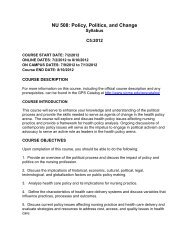SAINT JOSEPH'S COLLEGE DEPARTMENT OF NURSING
SAINT JOSEPH'S COLLEGE DEPARTMENT OF NURSING
SAINT JOSEPH'S COLLEGE DEPARTMENT OF NURSING
Create successful ePaper yourself
Turn your PDF publications into a flip-book with our unique Google optimized e-Paper software.
NU 420 Clinical 2012 13<strong>SAINT</strong> JOSEPH’S <strong>COLLEGE</strong><strong>DEPARTMENT</strong> <strong>OF</strong> <strong>NURSING</strong>Blood-Borne Pathogens PoliciesDepartment of Nursing Policies Regarding Human Immunodeficiency Virus(HIV) and Hepatitis B and C Viruses (HBV and HCV):A. HBV Immunization Policies1. All nursing majors are required to demonstrate immunity to Hepatitis B virus prior to beginning their firstclinical course. Beginning with fall registration for spring 2002 courses, any student not meetingimmunization policies will not be allowed to register for courses until they have met requirements. Studentswho for reasons of health refuse the vaccine must sign a waiver form available through the College’s StudentHealth Services.2. All nursing faculty members who have assignments requiring direct clinical supervision of students will beprovided an opportunity to receive the Hepatitis B vaccine as a Saint Joseph’s College employee. If a facultymember chooses not to receive the vaccine he/she will be asked to sign a waiver. Faculty members who havereceived Hepatitis B vaccines through another source will be asked to provide written documentation fortheir personnel files.B. Standard and Universal PrecautionsSaint Joseph’s College Department of Nursing conforms to the requirements of local, state, and federal laws and theCenters for Disease Control guidelines for preventing of HIV/HBV/HCV, as well as those of the parent institution andclinical site facilities. The following precautions are introduced in NU 190, Foundations of Nursing I and reinforced inNU 204, Foundations of Nursing II according to the recommendations set forth by the Centers for Disease Control andPrevention (CDC).Since medical history and examinations cannot reliably identify all patients infected with HIV or other blood-bornepathogens, blood and body fluid precautions should be consistently used for all patients. This approach, previouslyrecommended by the CDC, and referred to as “universal blood and body fluid precautions” or “universal precautions”,should be used in the care of all patients, especially including those in emergency care settings in which the risk ofblood exposure is increased and the infection status of the patient is usually unknown.1. All health care workers should routinely use appropriate barrier precautions to prevent skin and mucousmembrane exposure when contact with blood or other body fluids of any patient is anticipated. Glovesshould be worn for touching blood and body fluids, mucous membranes, or non-intact skin of all patients, forhandling items or surfaces soiled with blood or body fluids, and for performing venipuncture and othervascular access procedures. Gloves should be changed after contact with each patient. Masks and protectiveeye wear or face shields should be worn during procedures that are likely to generate droplets of blood orother body fluids to prevent exposure of mucous membranes of the mouth, nose, and eyes. Gowns andaprons should be worn during procedures that are likely to generate splashes of blood or other body fluids.2. Hands and other skin surfaces should be washed immediately and thoroughly if contaminated with blood orother body fluids. Hands should be washed immediately after gloves are removed.3. All health-care workers should take precautions to prevent injuries caused by needles, scalpels, and othersharp instruments; during disposal of used needles; and when handling sharp instruments after procedures.To prevent needle stick injuries, needles should not be recapped, purposely bent, broken by hand, removedfrom disposable syringes, or otherwise manipulated by hand. After they are used, syringes and needles,scalpel blades, and other sharp items should be placed in puncture-resistant containers for disposal; the
















